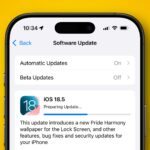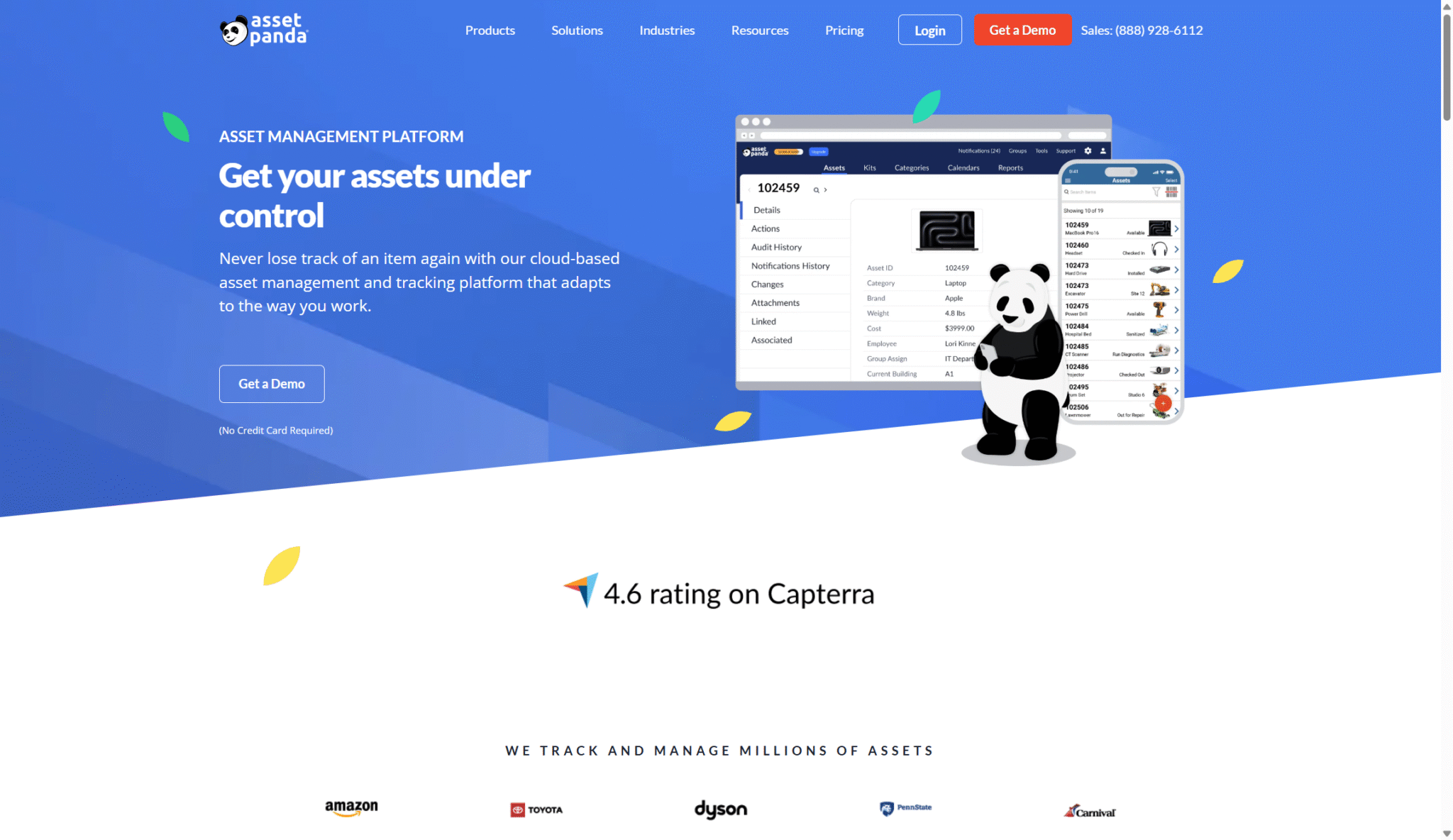Why you can trust TechRadar
We spend hours testing every product or service we review, so you can be sure you’re buying the best. Find out more about how we test.
Asset Panda is a cloud-based IT asset management software platform. It helps businesses track and manage their physical assets from anywhere. Its standout feature is a customizable interface that adapts to your workflows, so you don’t have to change your processes. The platform allows unlimited users on any plan, making it great for organizations that want to boost adoption.
During our testing, we were particularly impressed with its mobile features. Asset Panda includes built-in barcode scanning and GPS location tracking for assets. You can customize fields, workflows, and reports easily, even without coding skills. This empowers non-technical users to tailor the system to their needs. However, we noticed that the website lacks clear pricing. New users must request quotes based on the number of assets they want to track.
The software provides real-time visibility into asset status, location, and lifecycle history. This helps organizations make better decisions about maintenance, replacement, and use. We found the reporting tools to be strong, allowing us to create custom reports on asset depreciation and maintenance schedules. While the initial setup has a learning curve, Asset Panda’s customer support and onboarding help ease the transition.
All in all, Asset Panda offers great value. It improves accountability, reduces asset loss, and streamlines workflows. The company claims customers see an average 800% ROI, which seems believable based on our observations. Although the mobile app sometimes has syncing issues and lacks full offline functionality, the platform’s strengths make it a solid choice for businesses wanting to modernize their asset management.
Asset Panda: Plans and pricing
Asset Panda does not show pricing on its website. Instead, potential customers must contact sales for a custom quote based on their needs. The pricing mainly depends on the number of assets tracked, not the number of users, which is unlimited for all plans. We found that plans usually start at about $1,500 per year for small businesses tracking fewer than 500 assets. Enterprise pricing increases based on asset volume and custom implementation needs.
The company offers a 14-day free trial that provides full access to the platform’s features. This allows organizations to try its capabilities before making a commitment. We like that Asset Panda includes unlimited cloud storage, custom fields, and mobile app users in all plans. This avoids the extra charges seen with some competitors. Customer support, training resources, and regular updates are part of the subscription price. However, organizations needing more help can purchase premium onboarding and dedicated support packages for an extra cost.
Asset Panda: Features
Asset Panda provides a full set of tools for asset management. These tools help organizations track, manage, and optimize their physical assets throughout their lifecycle. The platform is flexible and supports various industries, including IT, facilities management, healthcare, education, and construction. Here are some standout features we found during testing.
Customizable workflows
Asset Panda’s flexible workflow engine lets users tailor the platform to fit their processes. We created custom fields, forms, and actions for our test environment without coding skills. The system has role-based permissions that manage what user groups can see and do. This ensures data security while promoting collaboration between departments.
Mobile functionality
The mobile app is one of Asset Panda’s best features. It offers almost all the desktop functions in a touch-friendly design. The built-in barcode scanner worked well with different asset tag types. Plus, capturing photos and attaching them to asset records was very helpful for documentation. The GPS tracking feature records location data when assets are scanned or updated. This creates a useful audit trail of asset movements.
Asset lifecycle management
Asset Panda tracks assets from start to finish. It covers procurement, deployment, maintenance, and retirement. The platform lets you schedule maintenance, track warranties, and monitor depreciation in one place. We appreciated the automated alerts for maintenance deadlines and warranty expirations. These alerts help avoid costly mistakes.
Integration capabilities
The platform provides strong integration options via its API and ready-made connectors for popular business systems. We personally tested the integrations with G Suite for user authentication and Zendesk for managing support tickets about asset issues. Plus connecting Asset Panda with accounting systems like QuickBooks and ERP platforms lets asset data move smoothly between key business systems. All of this cuts down on redundant data entry and boosts accuracy.
Asset Panda: Analytics
Asset Panda’s reporting tools offer clear insights into asset use, status, and financial performance. You can access both pre-built and custom reports. The dashboard is user-friendly, making it easy to view key metrics, such as asset distribution by location, maintenance status, and upcoming expirations. You can save reports for quick access and set up automated email delivery to stakeholders. This keeps everyone informed without extra work.
The platform’s filtering and grouping options let users analyze asset data in various ways to spot trends and find optimization opportunities. For example, you can create custom reports on depreciation forecasts, maintenance costs by asset type, and utilization rates across departments. The report builder may have a small learning curve for complex analyses, but even simple reports offer valuable insights.
Asset Panda: Ease of use
Asset Panda has a clean and modern interface that’s generally easy to use. However, the many customization options can be overwhelming for new users. Still, the platform balances power and usability well. It features logical navigation and helpful tooltips for common tasks. Your team can customize dashboards based on their roles, which helps streamline the experience. That way, team members see only the information relevant to their jobs.
The mobile experience is impressive. It offers almost all the features of the desktop version in a touch-friendly format. During our testing, we liked how easily we could switch between devices while maintaining access to key data and functions. The setup process does take time to customize fields, workflows, and permissions, but the implementation team is there to help new customers.
Asset Panda: Support
Asset Panda provides support through email, phone, and live chat during business hours. We were impressed by their quick response times. Their knowledge base is extensive, with detailed articles, video tutorials, and step-by-step guides for common questions and use cases. We especially appreciated the regular webinars and training sessions. These sessions cover basic functions and advanced features, like custom report building and workflow automation.
Asset Panda: Security
Asset Panda prioritizes data security. They use industry-standard measures like SSL encryption, regular security audits, and role-based access controls to keep customer information safe. And the platform runs on Amazon Web Services (AWS), which offers strong infrastructure security and compliance certifications like SOC 2 Type II.
We particularly liked the detailed permission settings during our evaluation. These settings let administrators manage what information different user groups can access, modify, or report on based on their roles at the company. This helps organizations maintain data integrity while promoting collaboration.
Asset Panda: The Competition
AssetCloud by Wasp is an affordable option for small businesses needing simple asset tracking. However, it doesn’t offer the extensive customization that Asset Panda does. EZOfficeInventory and Snipe-IT have similar core features at competitive prices. Snipe-IT even has an open-source option for groups that can self-host.
For enterprises using ServiceNow or IBM Maximo, their asset management modules integrate well with IT service management. However, they usually come at a much higher cost.
Organizations focused on IT asset management may prefer Lansweeper or ManageEngine AssetExplorer. These tools offer better automated discovery for networked devices. UpKeep and Fiix excel in maintenance management, which is important for groups prioritizing equipment uptime.
Asset Panda is flexible and serves many purposes, but these specialized tools can provide deeper functionality in certain areas. But they may lack the all-in-one appeal that Asset Panda has for managing diverse asset types.
Asset Panda: Final Verdict
Asset Panda offers a strong and customizable asset management solution. It adapts to many tracking needs across various industries. Its unlimited user model, mobile features, and customization options provide great value. However, pricing is not clear, and it has a steep learning curve. For organizations that rely on spreadsheets or outdated systems, Asset Panda brings a mix of flexibility and structure. This can change how assets are managed throughout their lifecycle.
We’ve also listed the best software asset management (SAM) tools.
Read the full article here















